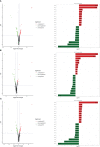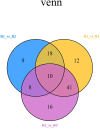Metabolome analysis reveals flavonoid changes during the leaf color transition in Populus × euramericana 'Zhonghuahongye'
- PMID: 37223816
- PMCID: PMC10200940
- DOI: 10.3389/fpls.2023.1162893
Metabolome analysis reveals flavonoid changes during the leaf color transition in Populus × euramericana 'Zhonghuahongye'
Abstract
Introduction: To investigate the mechanism of leaf color change at different stages in Populus × euramericana 'Zhonghuahongye' ('Zhonghong' poplar).
Methods: Leaf color phenotypes were determined and a metabolomic analysis was performed on leaves at three stages (R1, R2 and R3).
Results: The a*, C* and chromatic light values of the leaves decreased by 108.91%, 52.08% and 113.34%, while the brightness L values and chromatic b* values gradually increased by 36.01% and 13.94%, respectively. In the differential metabolite assay, 81 differentially expressed metabolites were detected in the R1 vs. R3 comparison, 45 were detected in the R1 vs. R2 comparison, and 75 were detected in the R2 vs. R3 comparison. Ten metabolites showed significant differences in all comparisons, which were mostly flavonoid metabolites. The metabolites that were upregulated in the three periods were cyanidin 3,5-O-diglucoside, delphinidin, and gallocatechin, with flavonoid metabolites accounting for the largest proportion and malvidin 3- O-galactoside as the primary downregulated metabolite. The color shift of red leaves from a bright purplish red to a brownish green was associated with the downregulation of malvidin 3-O-glucoside, cyanidin, naringenin, and dihydromyricetin.
Discussion: Here, we analyzed the expression of flavonoid metabolites in the leaves of 'Zhonghong' poplar at three stages and identified key metabolites closely related to leaf color change, providing an important genetic basis for the genetic improvement of this cultivar.
Keywords: Poplar ‘Zhonghong’; color change; flavonoids; leaves; metabolome analysis.
Copyright © 2023 Chen, Chang, Li, Huang, Zhou, Zhu and Liu.
Conflict of interest statement
The authors declare that the research was conducted in the absence of any commercial or financial relationships that could be construed as a potential conflict of interest.
Figures







Similar articles
-
Comparative Transcriptome and Metabolome Profiling Reveal Mechanisms of Red Leaf Color Fading in Populus × euramericana cv. 'Zhonghuahongye'.Plants (Basel). 2023 Oct 9;12(19):3511. doi: 10.3390/plants12193511. Plants (Basel). 2023. PMID: 37836251 Free PMC article.
-
Metabolome combined with transcriptome profiling reveals the dynamic changes in flavonoids in red and green leaves of Populus × euramericana 'Zhonghuahongye'.Front Plant Sci. 2023 Dec 21;14:1274700. doi: 10.3389/fpls.2023.1274700. eCollection 2023. Front Plant Sci. 2023. PMID: 38179486 Free PMC article.
-
Comparative Metabolomic Analysis Reveals Distinct Flavonoid Biosynthesis Regulation for Leaf Color Development of Cymbidium sinense 'Red Sun'.Int J Mol Sci. 2020 Mar 9;21(5):1869. doi: 10.3390/ijms21051869. Int J Mol Sci. 2020. PMID: 32182912 Free PMC article.
-
Transcriptome and metabolome analysis reveals anthocyanin biosynthesis pathway associated with ramie (Boehmeria nivea (L.) Gaud.) leaf color formation.BMC Genomics. 2021 Sep 22;22(1):684. doi: 10.1186/s12864-021-08007-0. BMC Genomics. 2021. PMID: 34548018 Free PMC article.
-
Comprehensive analysis of metabolome and transcriptome reveals the mechanism of color formation in different leave of Loropetalum Chinense var. Rubrum.BMC Plant Biol. 2023 Mar 8;23(1):133. doi: 10.1186/s12870-023-04143-9. BMC Plant Biol. 2023. PMID: 36882694 Free PMC article.
Cited by
-
Seasonal Variation of Polyphenols and Pigments in Ginkgo (Ginkgo biloba L.) Leaves: Focus on 3',8″-Biflavones.Plants (Basel). 2024 Oct 30;13(21):3044. doi: 10.3390/plants13213044. Plants (Basel). 2024. PMID: 39519962 Free PMC article.
-
Comparative Transcriptome and Metabolome Profiling Reveal Mechanisms of Red Leaf Color Fading in Populus × euramericana cv. 'Zhonghuahongye'.Plants (Basel). 2023 Oct 9;12(19):3511. doi: 10.3390/plants12193511. Plants (Basel). 2023. PMID: 37836251 Free PMC article.
-
Metabolome combined with transcriptome profiling reveals the dynamic changes in flavonoids in red and green leaves of Populus × euramericana 'Zhonghuahongye'.Front Plant Sci. 2023 Dec 21;14:1274700. doi: 10.3389/fpls.2023.1274700. eCollection 2023. Front Plant Sci. 2023. PMID: 38179486 Free PMC article.
-
Integrative analysis of transcriptome and metabolome provides insights into the mechanisms of leaf variegation in Heliopsis helianthoides.BMC Plant Biol. 2024 Jul 31;24(1):731. doi: 10.1186/s12870-024-05450-5. BMC Plant Biol. 2024. PMID: 39085772 Free PMC article.
-
Changes in Photosynthetic Characteristics between Green-Leaf Poplar Linn. "2025" and Its Bud-Sporting Colored-Leaf Cultivars.Int J Mol Sci. 2024 Jan 19;25(2):1225. doi: 10.3390/ijms25021225. Int J Mol Sci. 2024. PMID: 38279223 Free PMC article.
References
-
- Alcalde-Eon C., García-Estévez I., Rivas-Gonzalo J. C., Rodríguez-de-la C. D., Escribano-Bailón M. T. (2016). Anthocyanins of the anthers as chemotaxonomic markers in the genus populus l. differentiation between populus nigra, populus alba and populus tremula. Phytochemistry 128, 35–49. doi: 10.1016/j.phytochem.2016.04.004 - DOI - PubMed
-
- Carle J. (2005). Challenges of translating science into practice: poplars and other species in the three north region of China. Unasylva/Englische Ausgabe: an Int. Rev. forestry For. industries 56, 221.
-
- Chen M., Li H., Zhang W., Huang L., Zhu J. (2022). Transcriptomic analysis of the differences in leaf color formation during stage transitions in Populus × euramericana ‘Zhonghuahongye’. Agronomy 12, 2396. doi: 10.3390/agronomy12102396 - DOI
LinkOut - more resources
Full Text Sources

